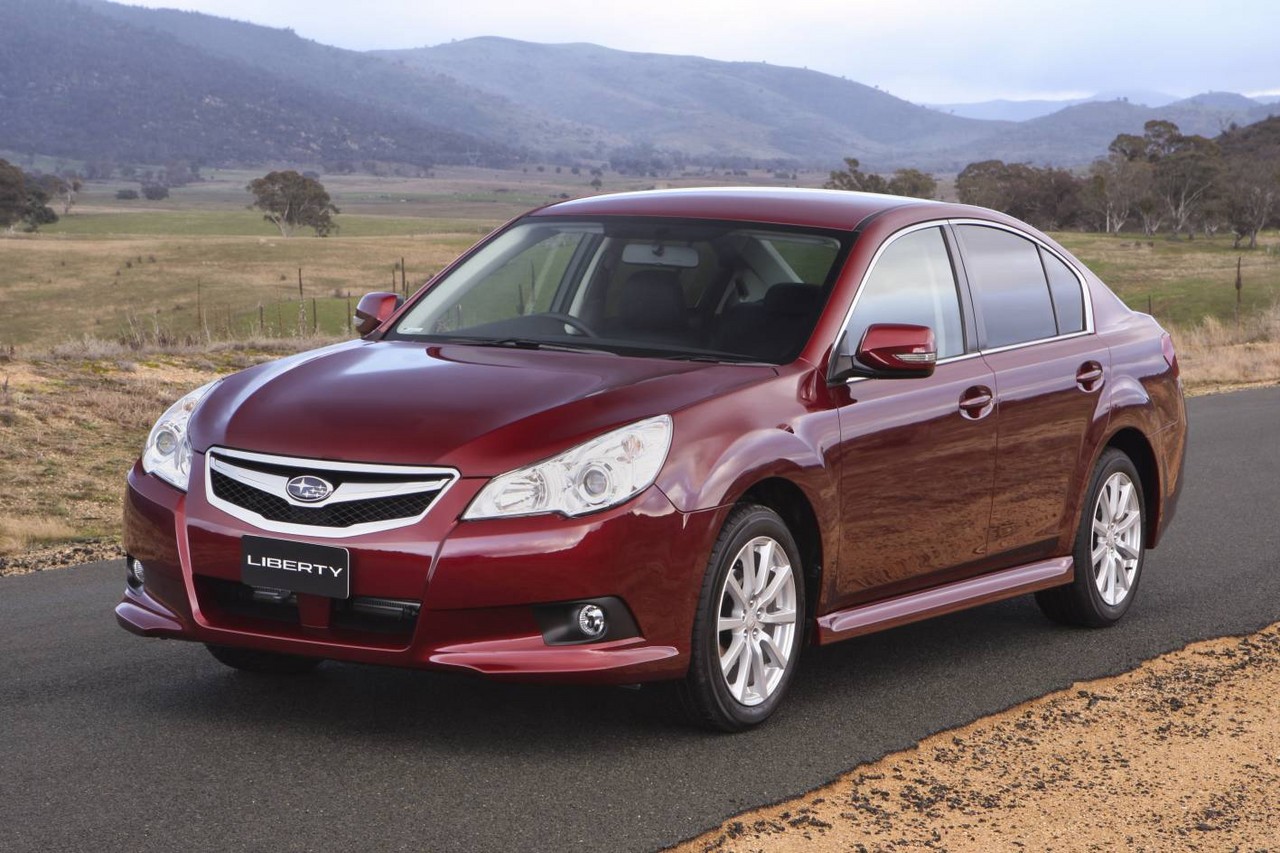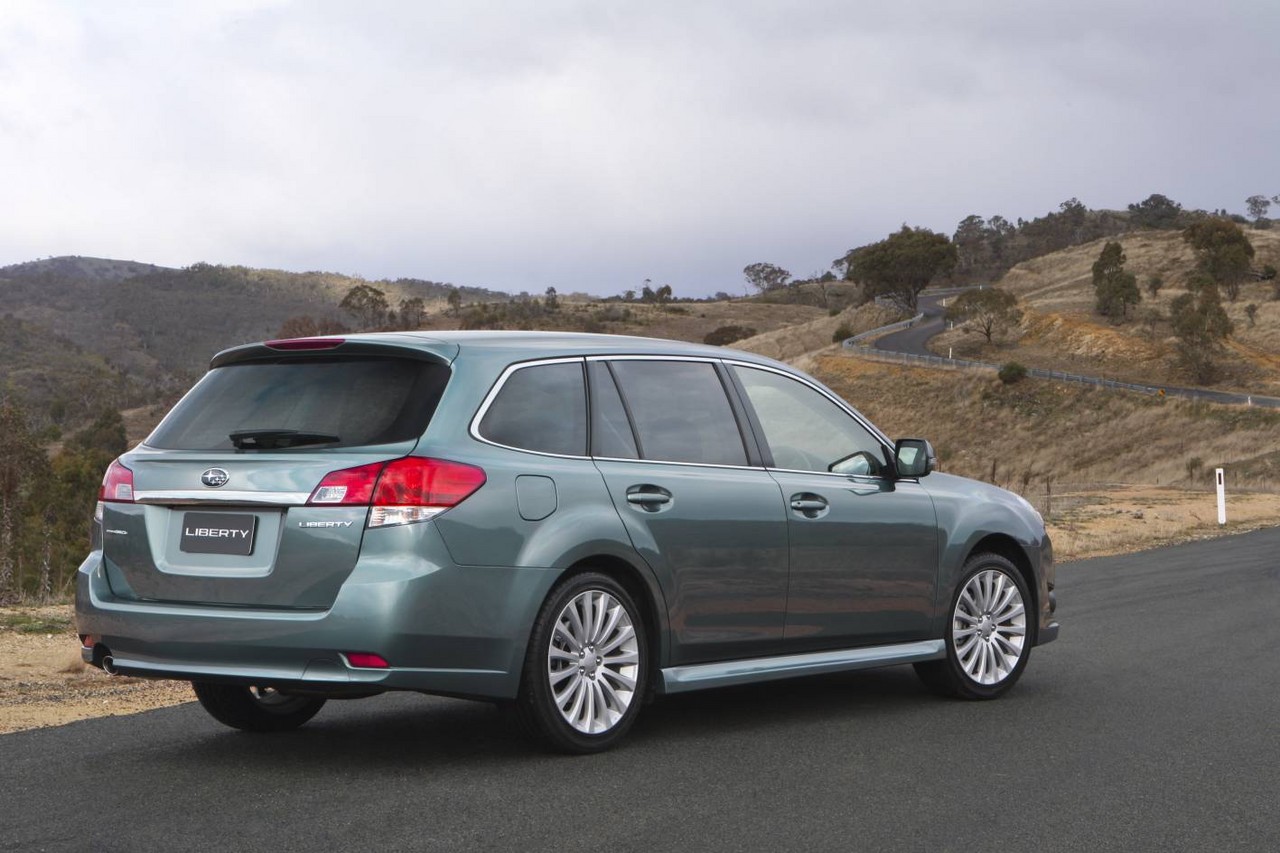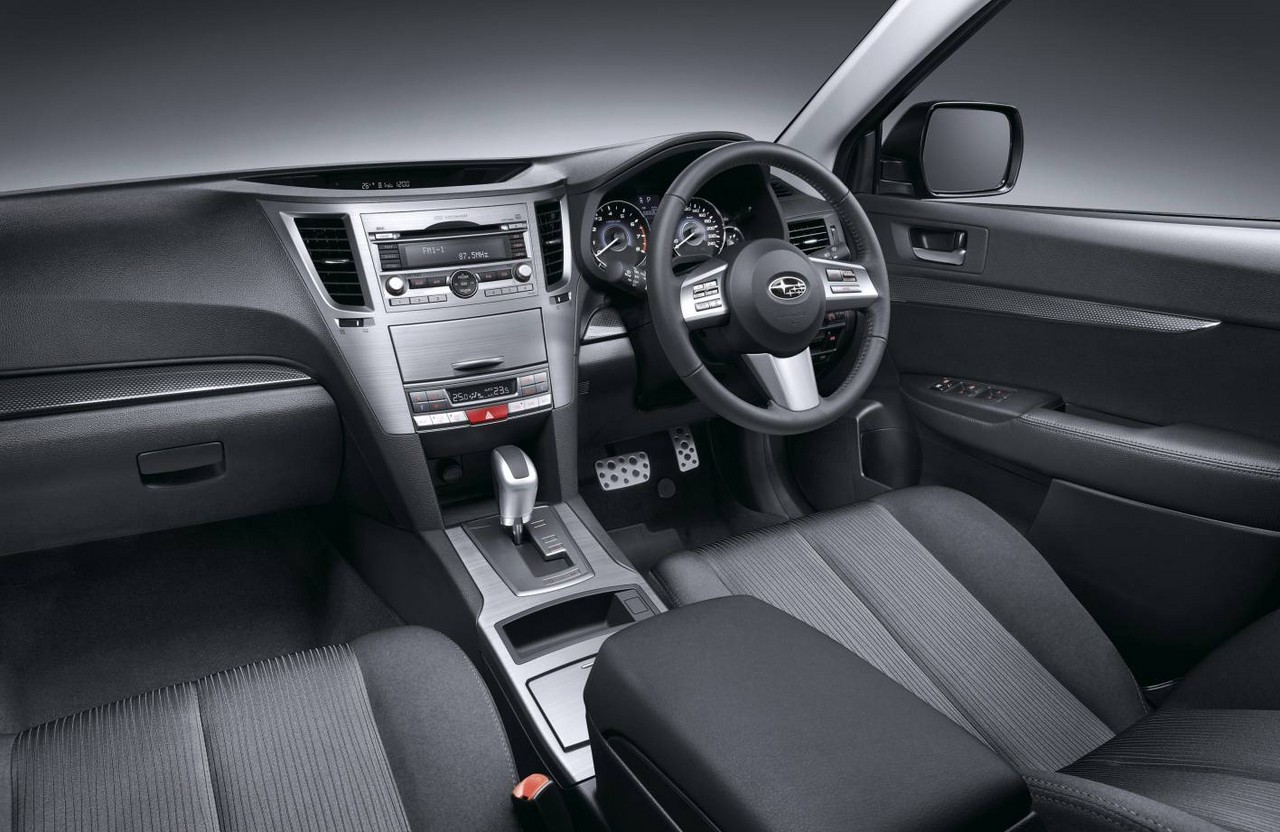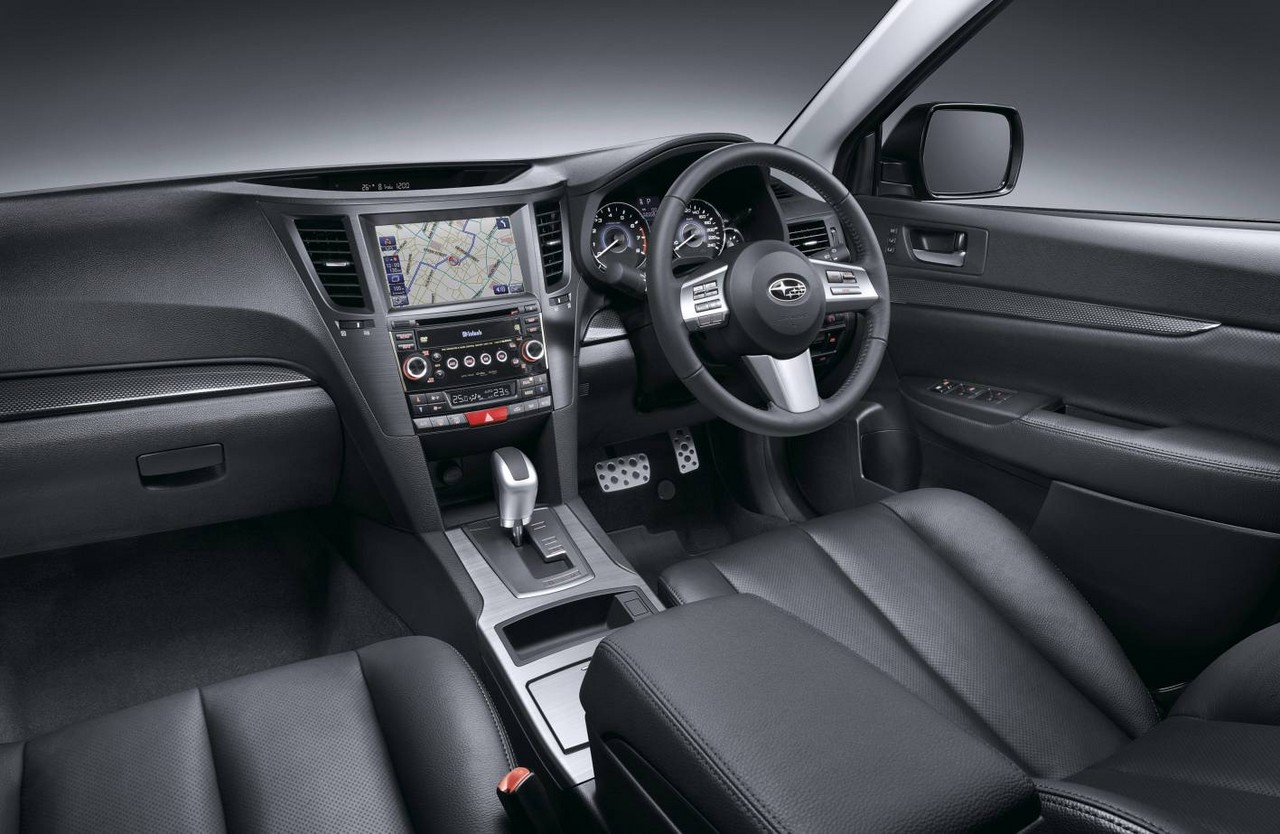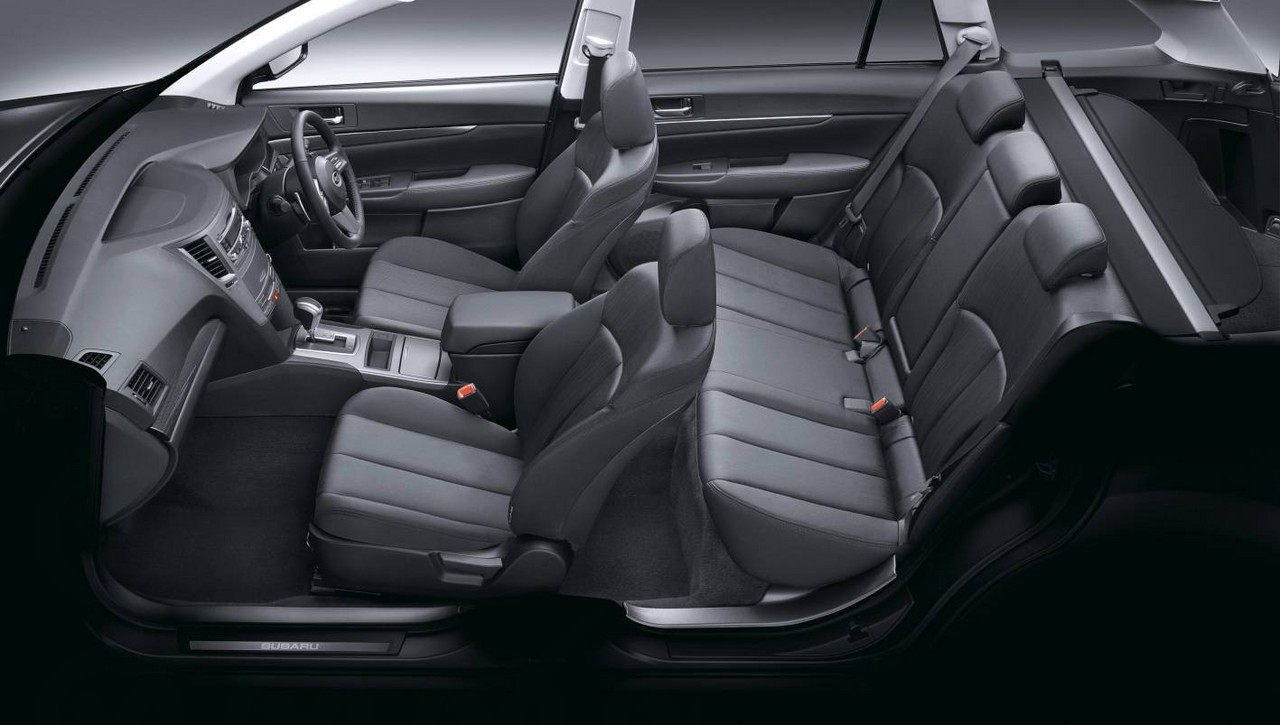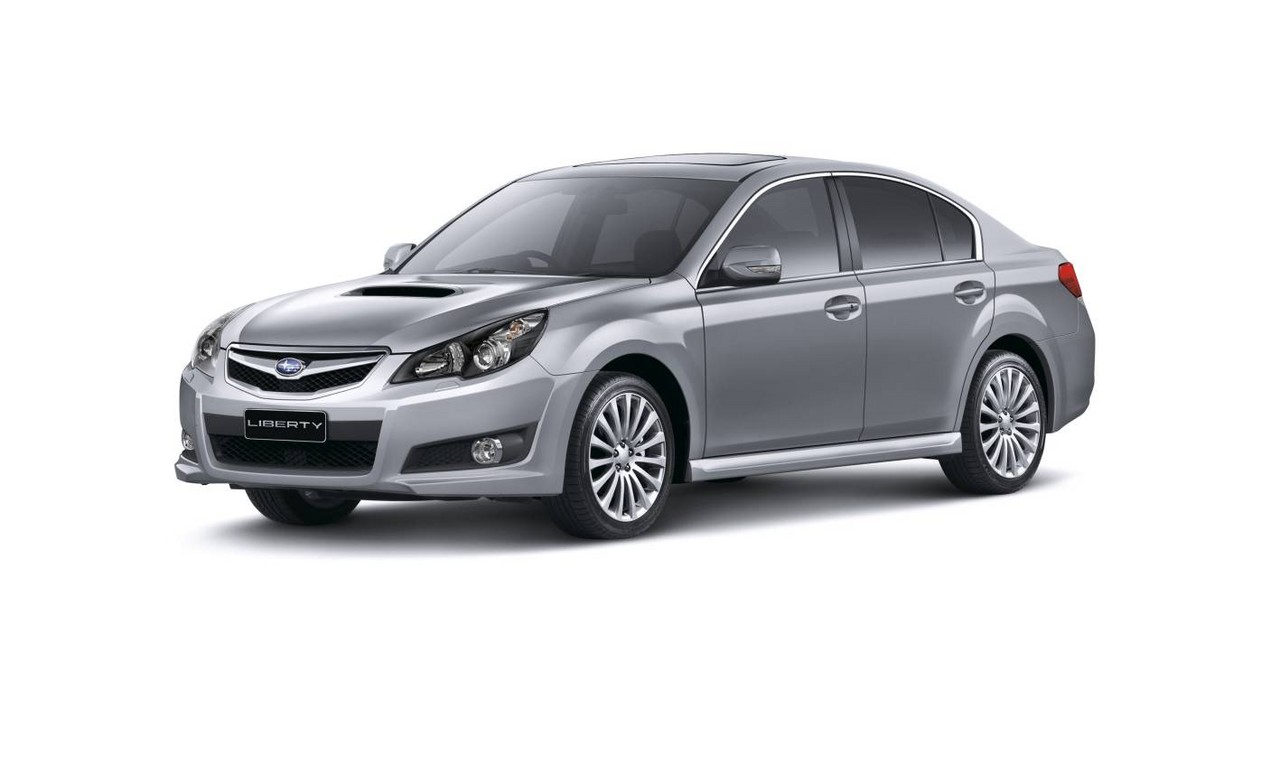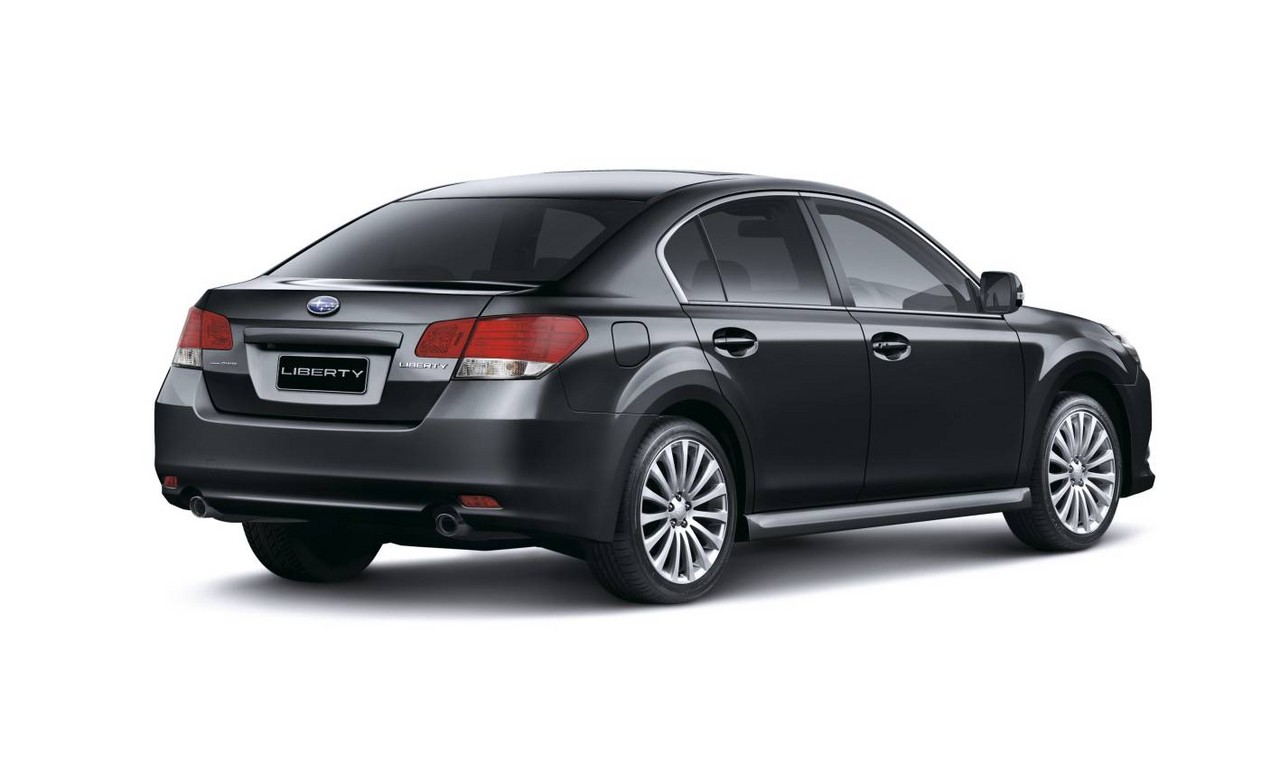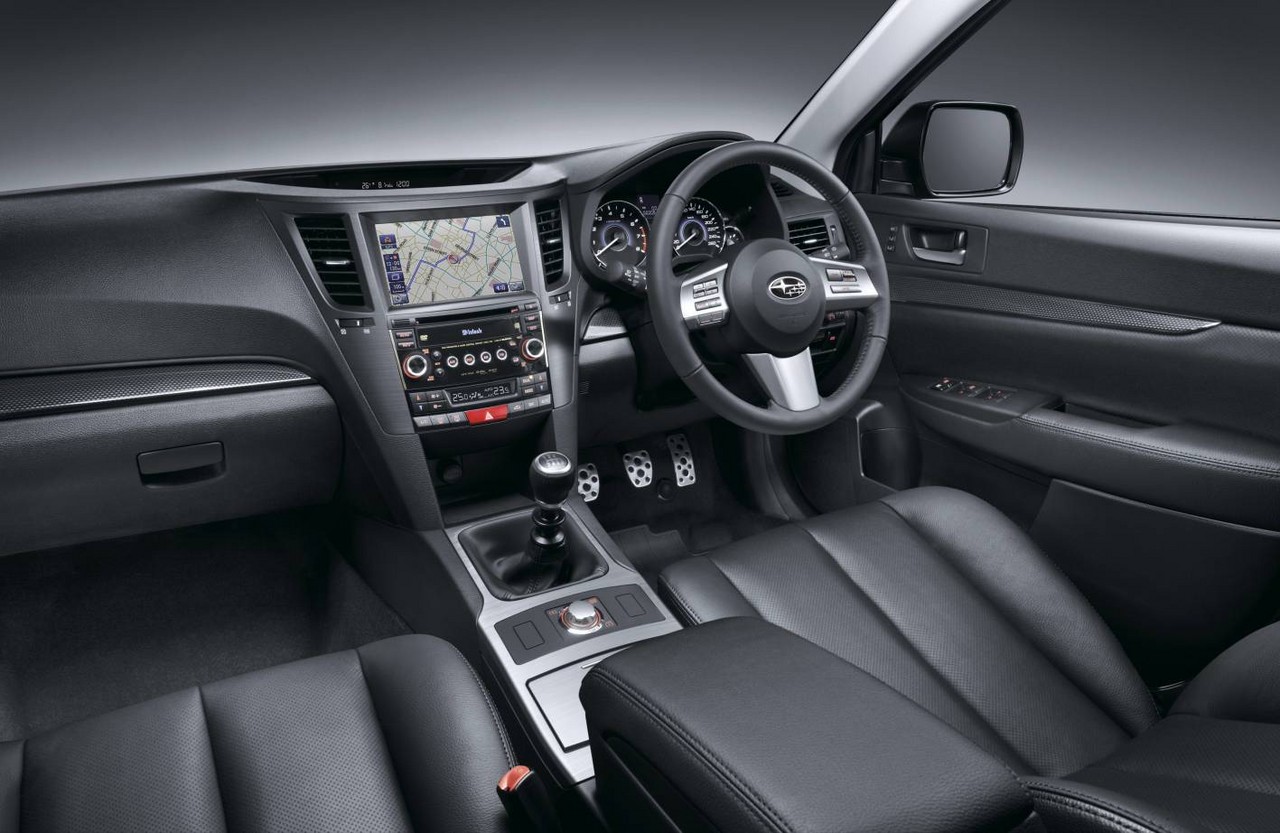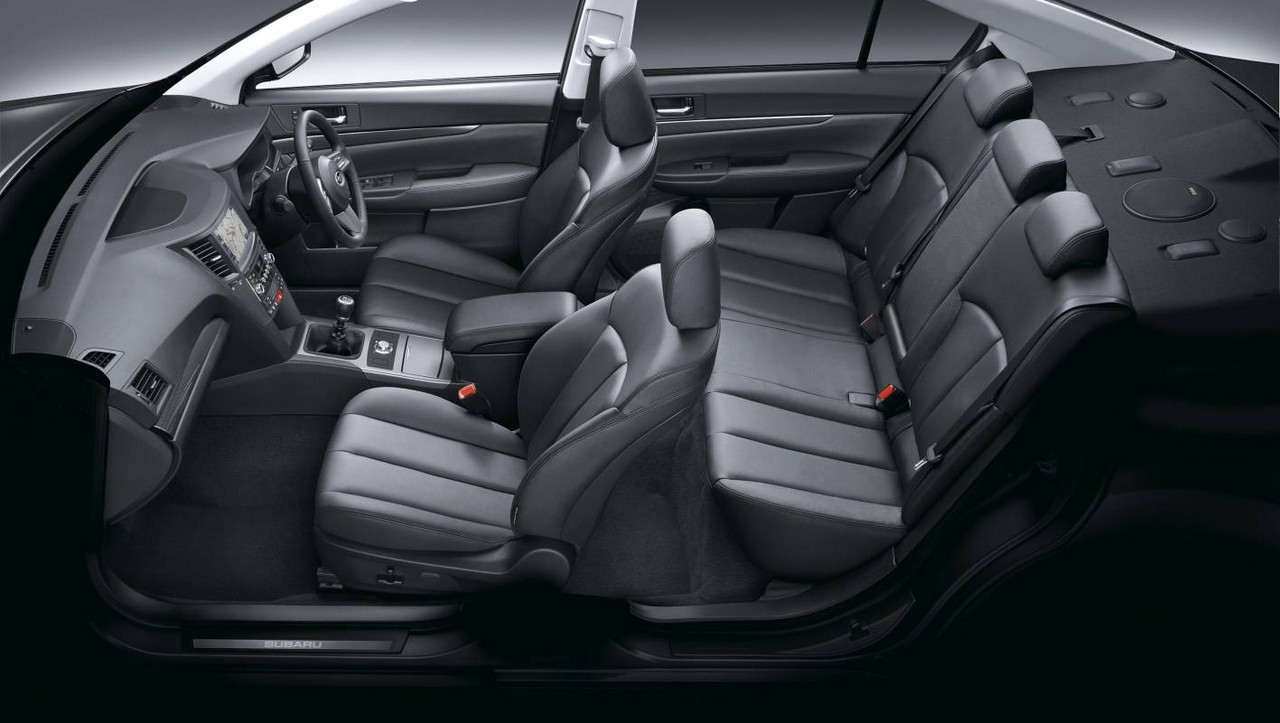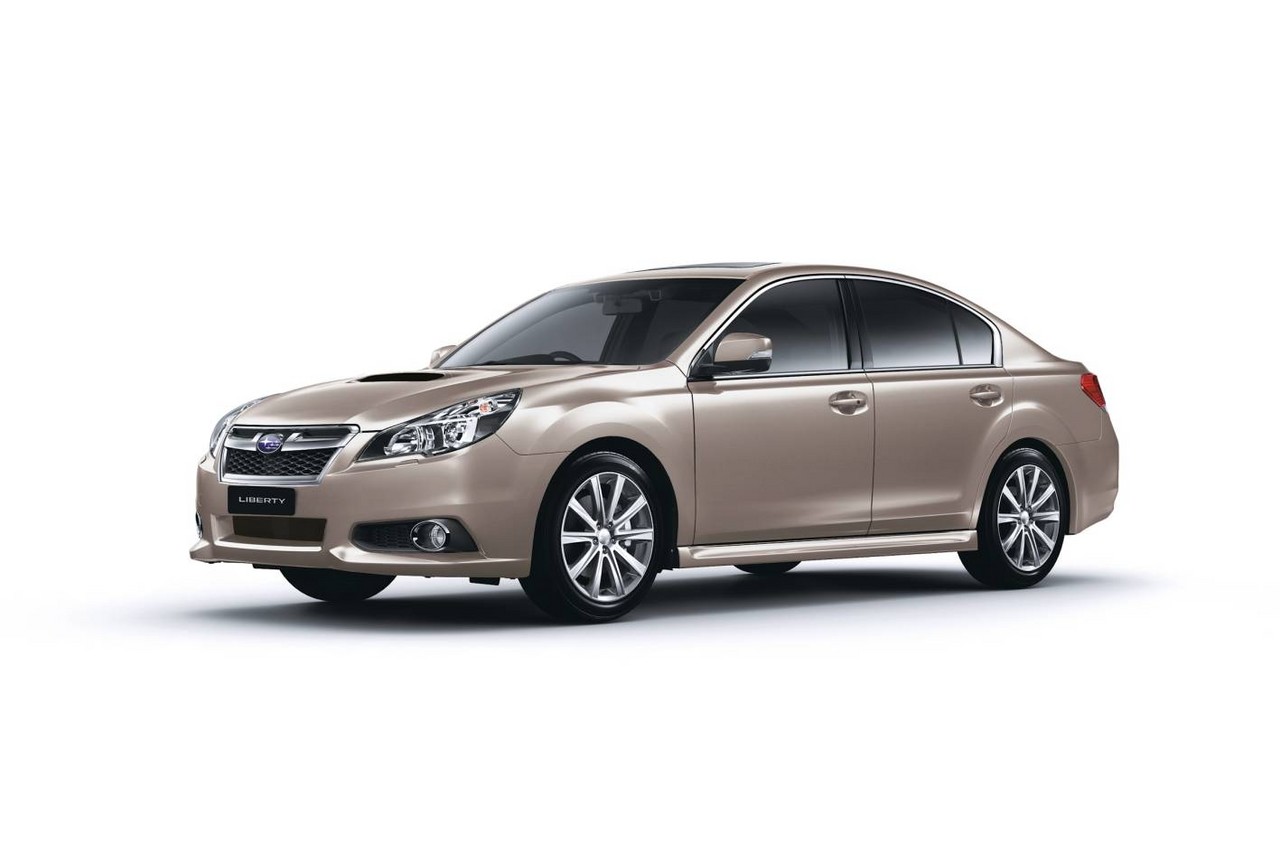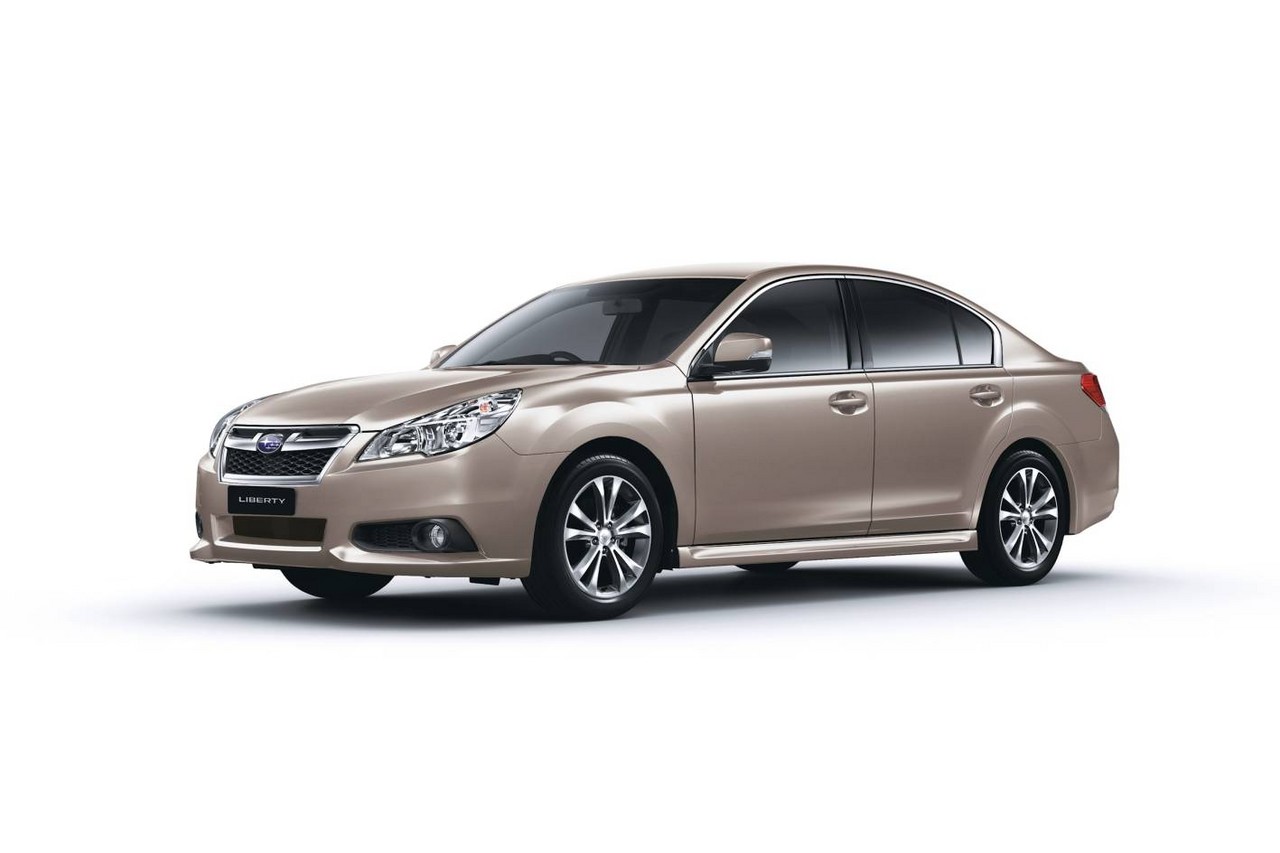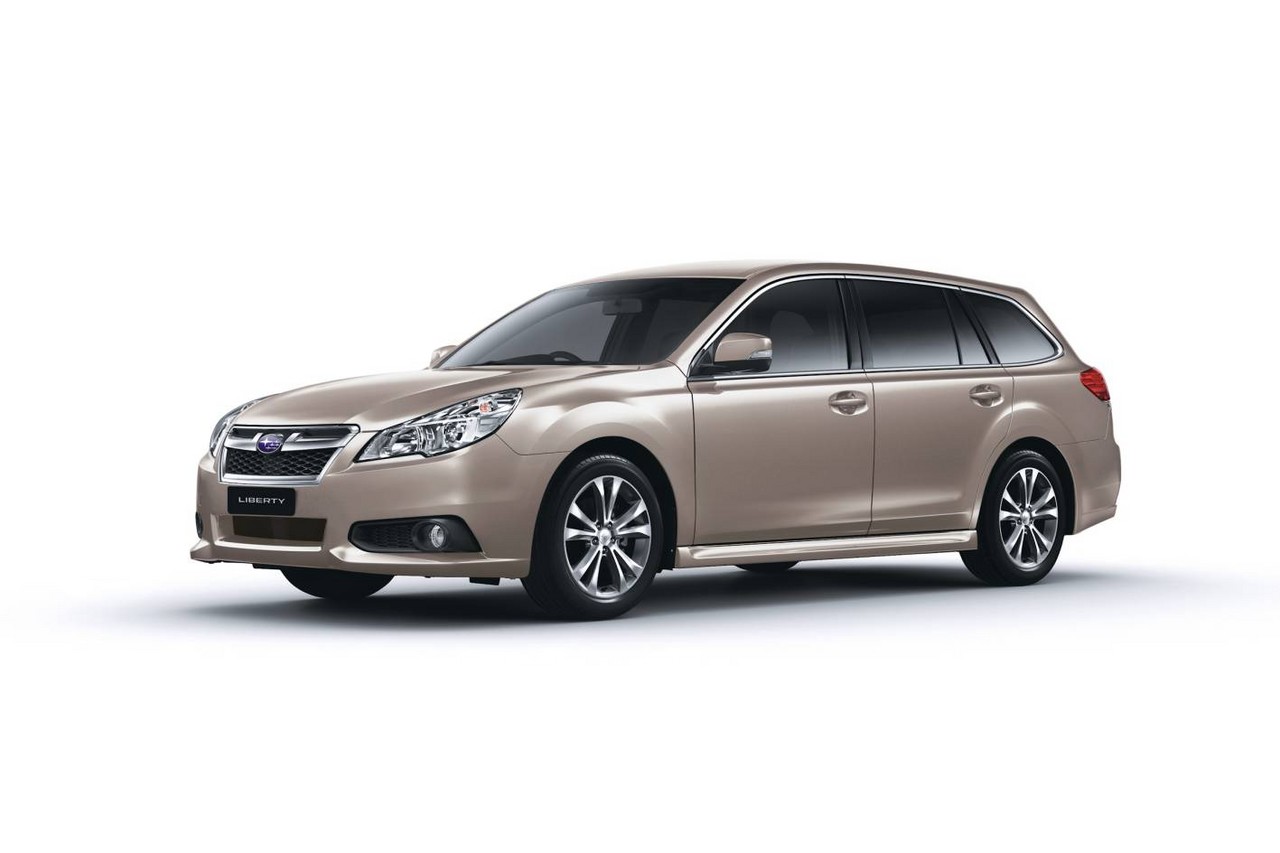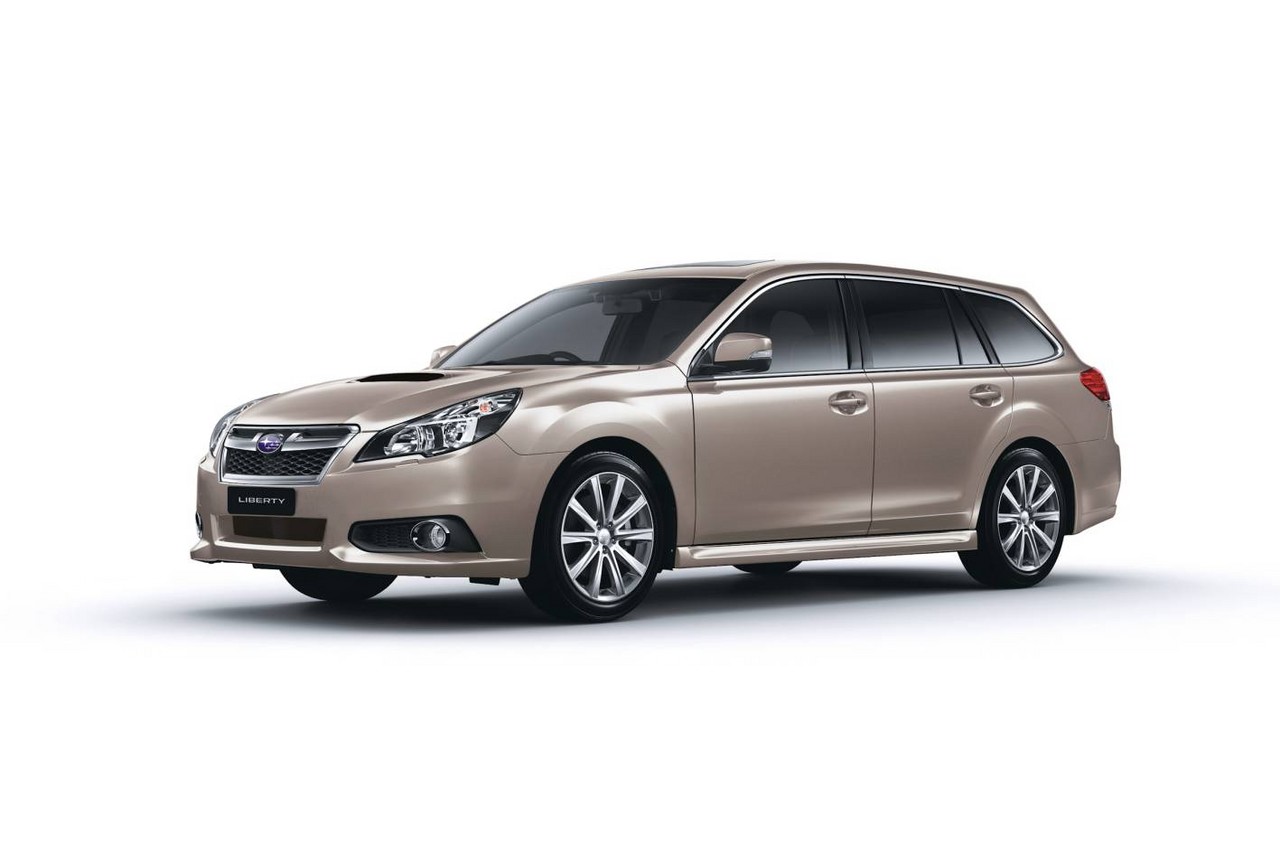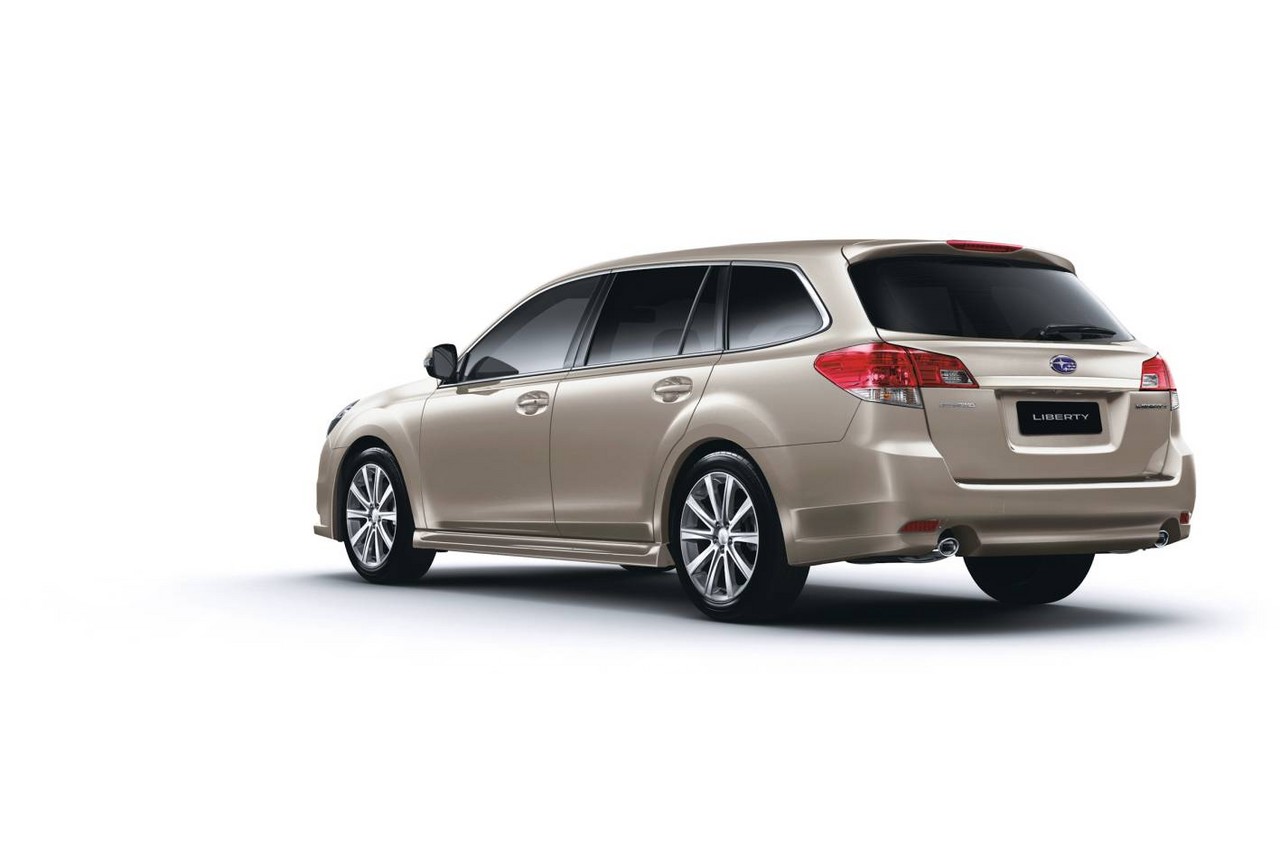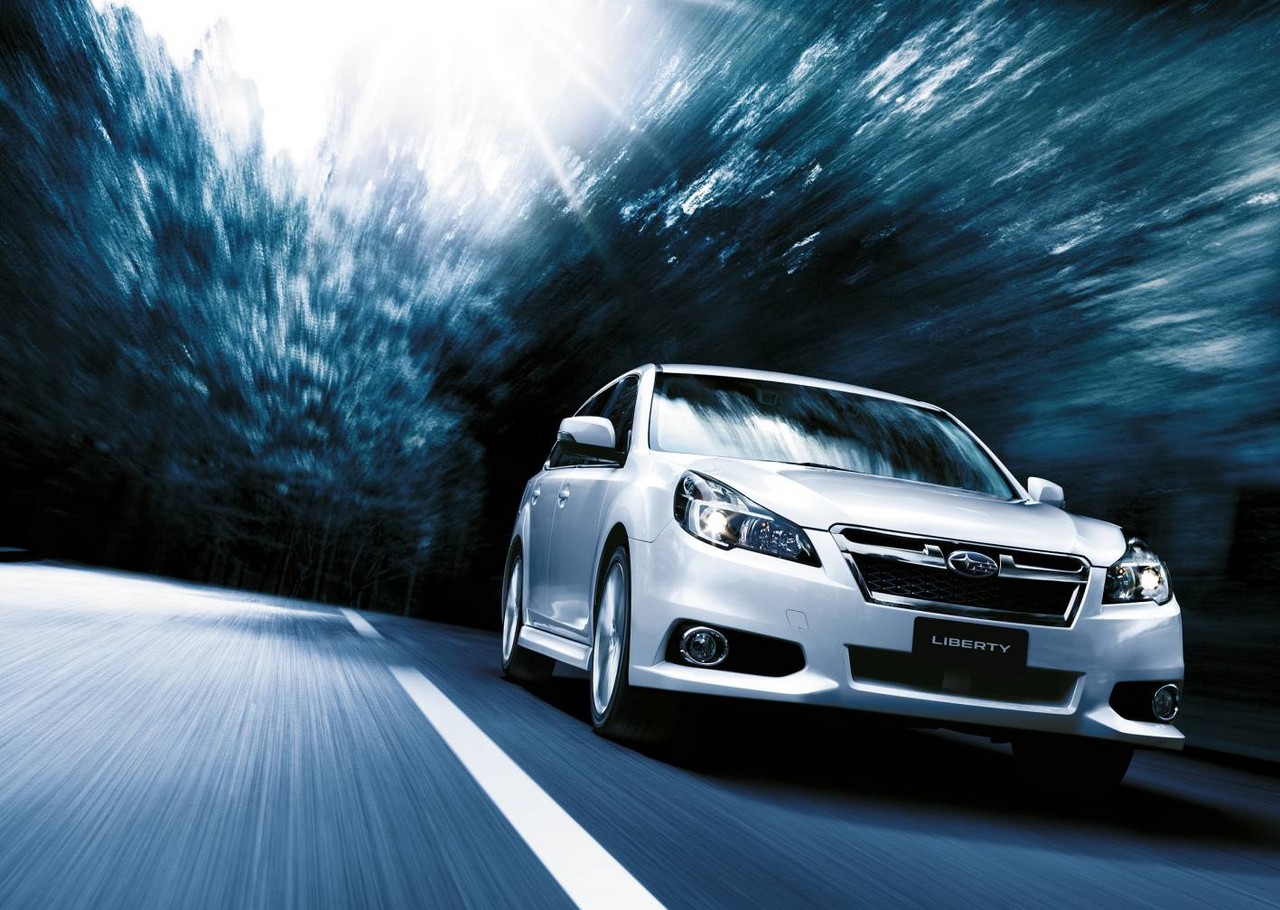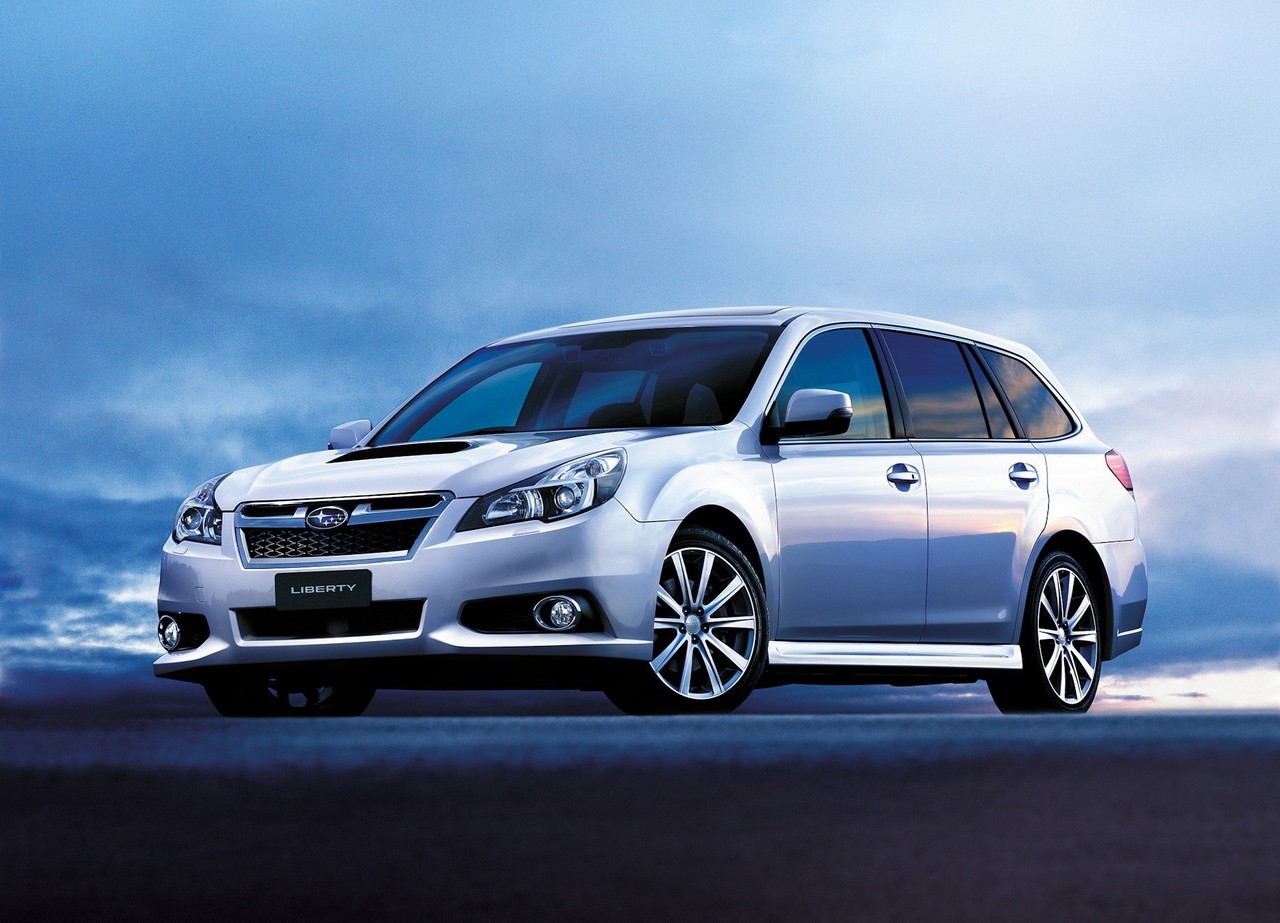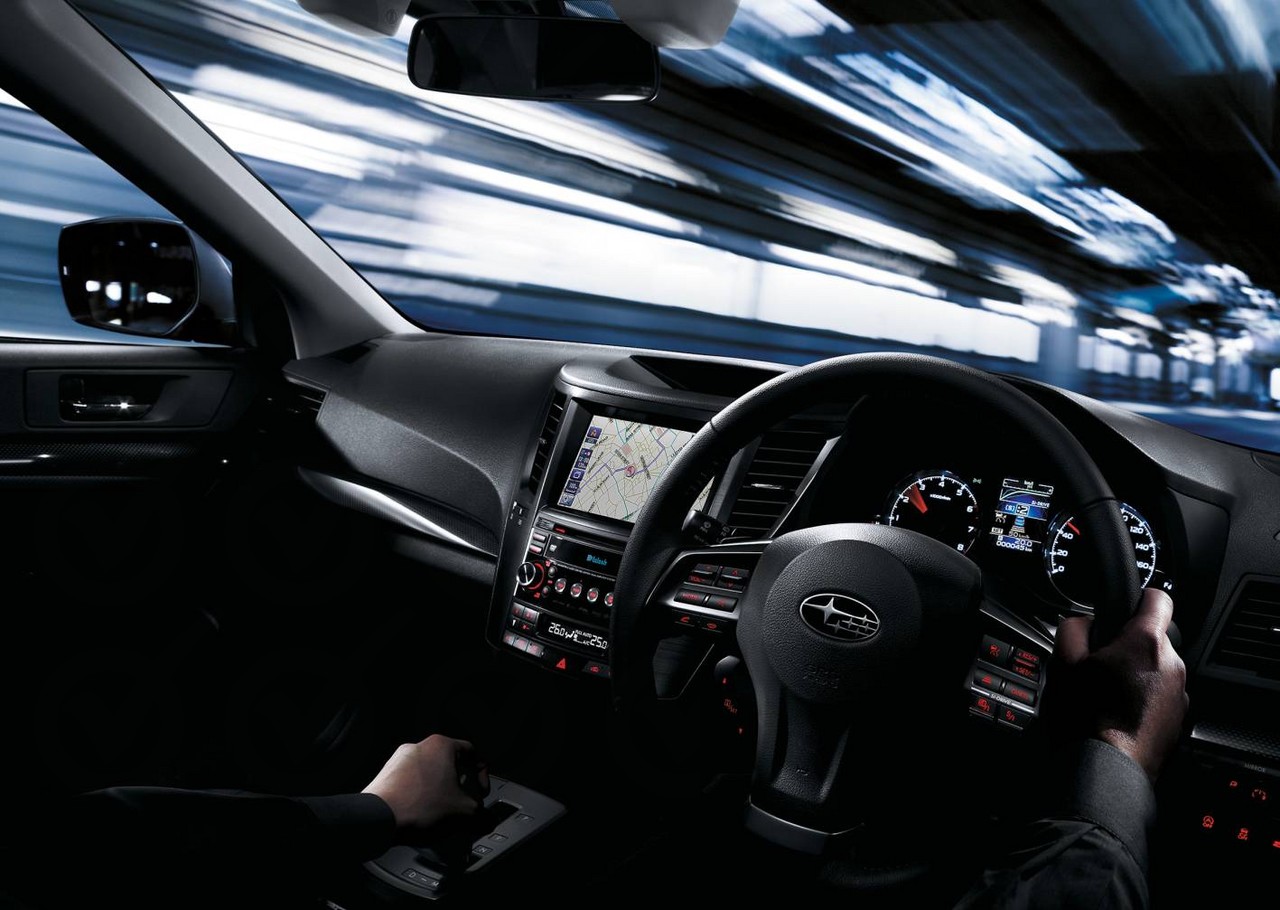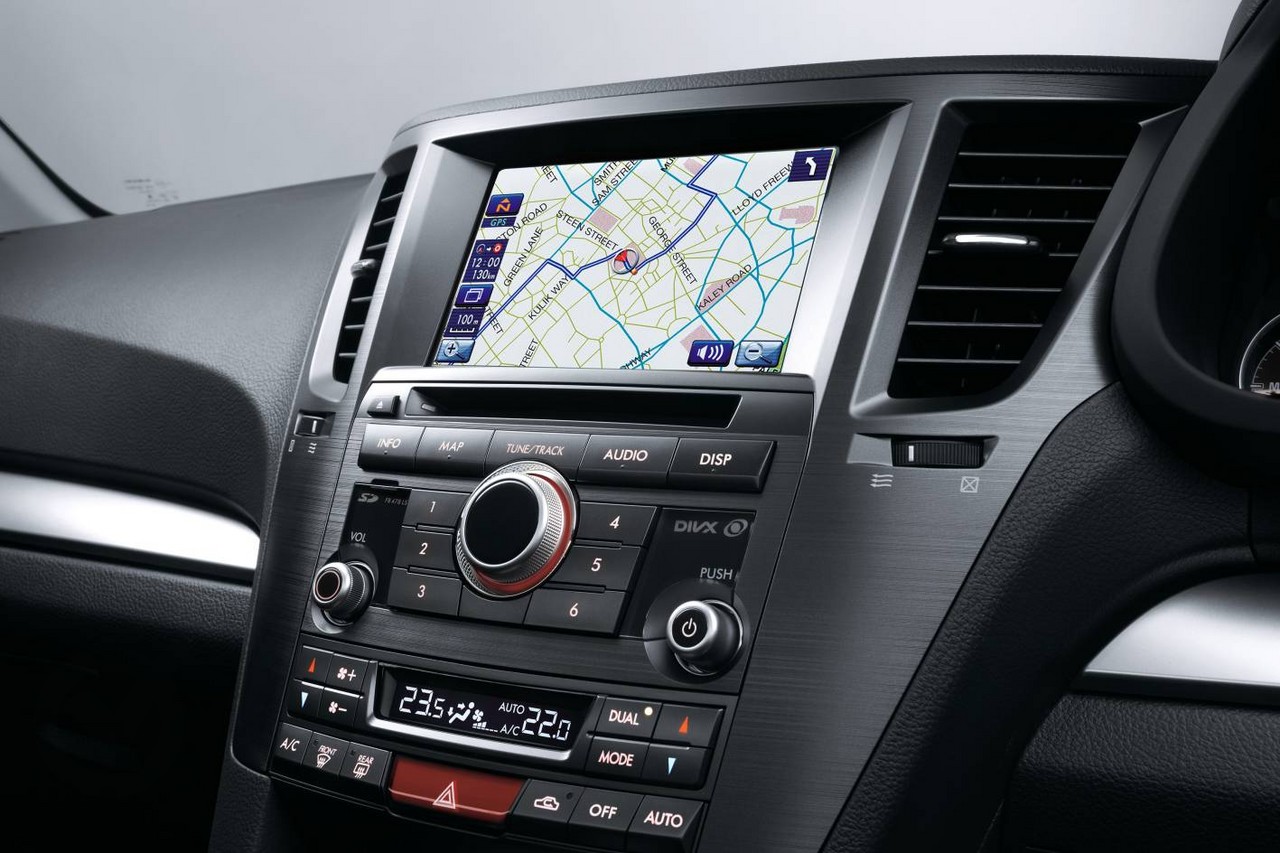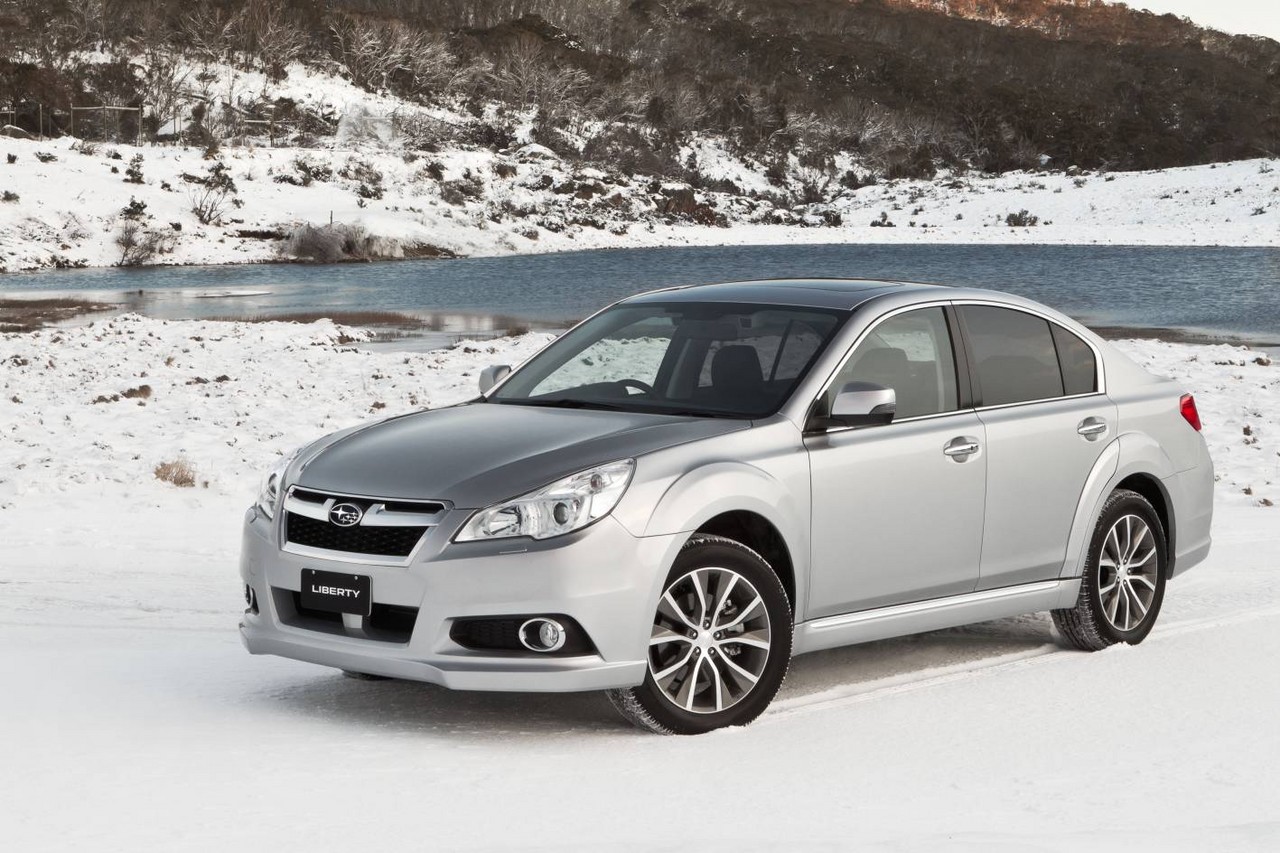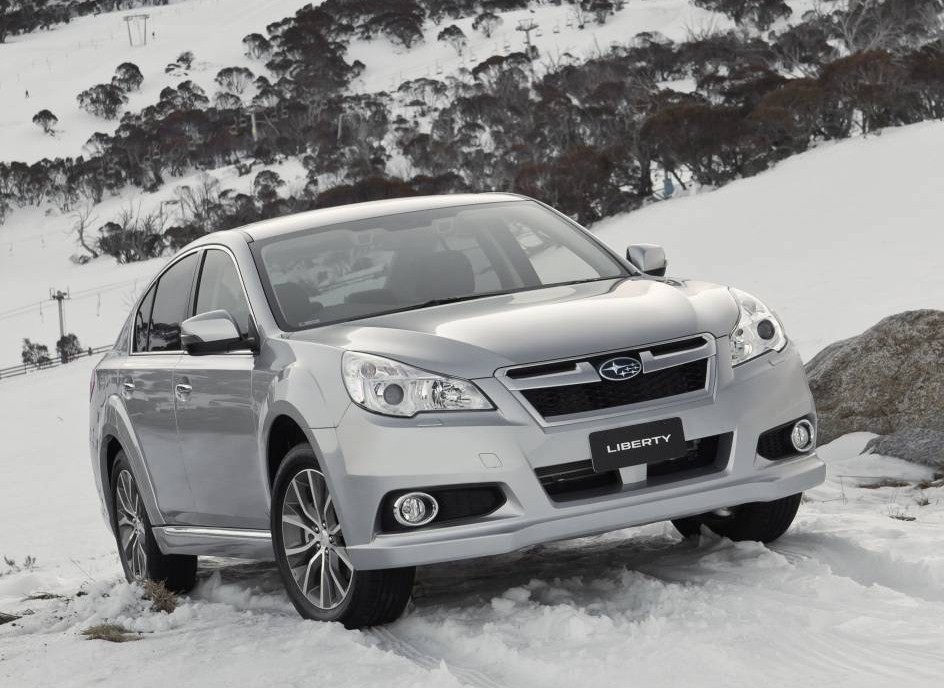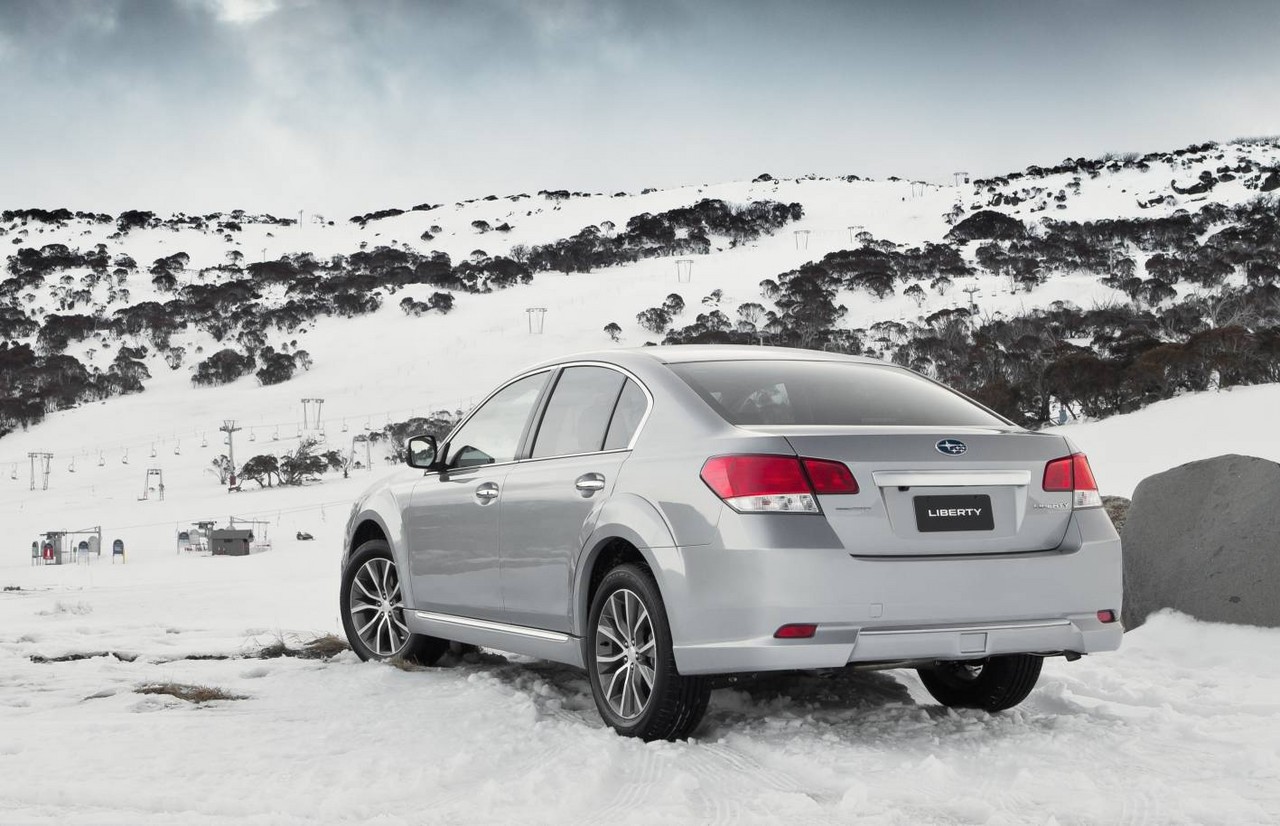
- Refined 3.6-litre six-cylinder engine
- All-wheel drive traction (via three very different systems)
- Competent ride/handling balance
- Spacious interior
- Supportive driver’s seat
- Accurate steering
- Suspension for Liberty GT lacks compliance
- Hard interior plastics
- For 2.5-litre petrol engine, CVT torque converter may cause low engine rpm when coming to rest due to worn thrust washer
- For 2.5-litre petrol engine, rare cases of head gasket failure
Review: Subaru BM.I/BR.I Liberty (2009-12)
Overview
Released in September 2009, the fifth-generation Subaru Liberty was available as a mid-size sedan (BM) or wagon (BR). Manufactured in Ota, Japan, the all-wheel drive Subaru BM.I/BR.I Liberty range was available with three horizontally-opposed (or flat) petrol engines.
EJ253, EJ255 and EZ36D engines
Of the engines,
- For the Liberty 2.5i, the EJ253 engine had an open-deck aluminium alloy block with cast iron liners, an aluminium alloy cylinder head, a single overhead camshaft per cylinder bank (belt-driven), four valves per cylinder, Tumble Generator Valves (TGV) and a compression ratio of 10.0:1. For the BM/BR Liberty, the EJ253 engine included Subaru’s ‘Intelligent Active Valve Lift System’ (i-AVLS’) which could vary the lift of one intake valve per cylinder between low and high lift profiles. At lower engine speeds, the low lift profile increased the speed of the intake air and swirl within the combustion chamber. At higher engine speeds, the high lift profile reduced intake resistance for greater power;
- For the Liberty GT, the turbocharged 2.5-litre EJ255 engine had a semi-closed die-cast aluminium block with cast iron liners, an aluminium cylinder head with cross-flow cooling, double overhead camshafts per cylinder bank (belt-driven), four valves per cylinder, variable intake and exhaust valve timing (Subaru’s ‘Dual Active Valve Control System’ or Dual AVCS), Tumble Generator Valves (TGVs) and a compression ratio of 8.4:1. For the BM Liberty GT, the EJ255 engine was fitted with an IHI VF45 (RHF5H) turbocharger which provided maximum boost pressure of 87 kPa (12.6 psi); and,
- For the Liberty 3.6R, the 3.6-litre EZ36D engine had an open-deck aluminium block, an aluminium cylinder head with parallel-flow cooling, double overhead camshafts (chain-driven), four valves per cylinder, variable intake and exhaust valve timing (Subaru’s ‘Dual Active Valve Control System’ or ‘Dual AVCS’) and a compression ratio of 10.5:1.
Development and dimensions
The Subaru BM/BR Liberty bodyshell was stronger than its predecessors and included framed sash windows and wider opening doors. The BM/BR Liberty also introduced a ‘Lineartronic’ continuously variable transmission (CVT) with six pre-set ratios and steering wheel gearshift paddles.
Compared to the Subaru BL Liberty , the BM Liberty sedan was 80 mm longer (at 4745 mm), 50 mm wider (1780 mm), 80 mm taller (1505 mm) and had a 80 mm longer wheelbase (2750 mm). Relative to its BM sedan counterpart, the BR Liberty was 40 mm longer (at 4785 mm) and had a 30 mm higher roofline (1535 mm).
Suspension
The Subaru BM and BR Liberty had MacPherson strut front suspension and double wishbone rear suspension (both with coil springs, gas-filled dampers and anti-roll bars).
| Body | Variant | Edition | Engine | Trans. | Peak power | Peak torque |
|---|---|---|---|---|---|---|
| Sedan or wagon |
2.5i | N/A | 2.5-litre EJ253 petrol F4 |
6sp man,. 6sp CVT |
123 kW at 5600 rpm | 229 Nm at 4000 rpm |
| Premium, Sports, Sports Premium |
2.5-litre EJ253 petrol F4 |
6sp CVT | ||||
| GT | Premium | 2.5-litre EJ255 turbo petrol F4 |
5sp auto, 6sp man. |
195 kW at 5600 rpm | 350 Nm at 2400-5200 rpm | |
| Sedan | 3.6R | Premium | 3.6-litre EZ36D petrol F6 |
5sp auto | 191 kW at 5600 rpm | 350 Nm at 4400 rpm |
AWD systems
Within the Subaru BM/BR Liberty range, there were three all-wheel drive (AWD) systems:
- 2.5i variants with six-speed manual transmissions were fitted with Subaru’s ‘Continuous’ AWD system which utilised a viscous-coupling locking centre differential. In normal conditions, the system provided a 50:50 front:rear torque distribution. If traction was lost, however, up to 80 per cent of the engine’s torque could be directed to the opposing axle.
- 2.5i variants with CVTs were fitted with an ‘Active Torque Split’ system which consisted of an electronically-controlled, hydraulic multi-plate transfer clutch (instead of the centre differential). In normal conditions, the system provided a 60:40 front:rear torque split but sensors – measuring wheel slippage, throttle position and braking – could anticipate a loss of front-wheel traction and transfer torque to the rear axle.
- 3.6R variants were fitted with a ‘Variable Torque Distribution’ system whereby a planetary center differential operated in conjunction with an electronically-controlled continuously variable hydraulic transfer clutch. In normal conditions, the system provided a 45:55 front:rear torque split, though this was continuously adjusted according to driving and road conditions.
Safety equipment
Standard safety equipment for the Subaru BM and BR Liberty included dual front airbags, a driver’s knee airbag, front side airbags, full-length curtain airbags (i.e. for front and rear occupants), ABS, electronic brake force distribution, brake assist, electronic stability control, traction control and front seatbelts with pretensioners and load limiters.
Brakes
The Subaru BM/BR Liberty was fitted with aluminium brake calipers, ventilated front disc brakes and solid rear disc brakes, except for the 2.5i Sports and 2.5 GT which had ventilated rear disc brakes. Compared to its fourth-generation predecessor, a newly designed brake booster with a high response valve improved braking performance by around 20 per cent.
ANCAP and Euro NCAP crash testing
In ANCAP crash testing , a 2009 Subaru BR Outback received a five star adult occupant protection rating with a score of 34.8 out of 37. As a result of evidence provided by Subaru to ANCAP, this rating was also applied to the Liberty wagon. In the frontal offset crash test, protection from serious leg injury was marginal for the driver. In the side impact and pole tests, however, the Outback received maximum points.
In Euro NCAP testing , a 2009 Subaru BR Liberty wagon (sold in Europe as the Legacy) received a five star safety rating which included a 79 per cent adult occupant protection rating and a 73 per cent child occupant protection rating. In the frontal offset crash test, protection of the driver’s head and feet were rated as good, though chest protection was rated as adequate and thigh protection as marginal. Maximum points were awarded in the side impact test; in the more severe pole test, however, chest protection was rated as weak.
Features: Liberty 2.5i
Standard features for the Subaru BM/BR Liberty 2.5i included 17-inch alloy wheels, a six speaker Kenwood ‘Sound Meister’ sound system with a six-stack CD player, auxiliary inputs and MP3/WMA-compatibility, dual zone climate control air conditioning, steering wheel audio and cruise controls, front fog lights, a leather-wrapped steering wheel, remote central locking, power mirrors and windows, an electric park brake, a height and reach adjustable steering wheel, height adjustable driver’s seat, 12 volt power outlets, trip computer, rear privacy glass and an immobiliser; Liberty wagon models also had a 60/40 split and folding rear seat. From November 2010, Bluetooth mobile phone connectivity was fitted as standard.
The Liberty 2.5i Premium added leather seats, an eight-way power adjustable driver’s seat with memory settings, rear air conditioning vents, a power sunroof and Bluetooth connectivity.
Compared to the 2.5i, the Liberty 2.5i Sports added 18-inch alloy wheels with Bilstein suspension, xenon headlights with washers, alloy pedals and a ‘sports’ front bumper and grille. The Sports Premium was further equipped with leather seats, an eight-way power adjustable driver’s seat with memory settings and a power sunroof.
Features: Liberty GT and 3.6R
The Liberty GT Premium and 3.6R Premium were distinguished by their 18-inch alloy wheels, ten speaker McIntosh sound system with single disc CD/DVD player, leather seats, an eight-way power adjustable driver’s seat with memory settings, a power adjustable front passenger seat, satellite navigation, a reversing camera, xenon headlights with washers, Bluetooth connectivity, rain-sensing wipers, a power sunroof, proximity key and keyless ignition; automatic models were also fitted with steering wheel gearshift paddles
The Liberty GT Premium and 3.6R Premium also featured ‘Subaru Intelligent Drive’ (SI-Drive) which enabled the driver to select from ‘Intelligent’, ‘Sport’ and ‘Sport #’ driving modes via a rotary dial on the centre console.
December 2011: Liberty update
In December 2011, the Liberty range was updated for the 2012 model year. Standard features were extended to include USB connectivity, leather seats, an eight-way power adjustable driver’s seat, reversing camera and a full-size spare wheel; the Premium and Sports Premium editions also gained satellite navigation as standard.
Furthermore, the Liberty 3.6R Premium was equipped with Subaru’s ‘EyeSight’ system which used minute sound system cameras to detect road hazards and alert the driver. The EyeSight system also included emergency braking preparation, autonomous braking, pre-collision throttle management, adaptive cruise control, lane departure warning, vehicle sway warning and ‘lead vehicle start alert’, which alerted the driver when the vehicle in front started to accelerate from rest.
Related links
- Brochure: Subaru BM.I/BR.I Liberty (November 2010)
- Subaru News: Liberty And Outback Tune In Wireless (November 2010)
- Brochure: Subaru BM.I/BR.I Liberty (December 2011)
- Subaru News: Liberty adds value – reversing cameras now range-wide (December 2011)
Review: Subaru BM.II/BR.II Liberty (2012-14)
Overview
Released in September 2012, the Subaru BM and BR Series II (BM.II/BR.II) or MY13 Liberty range initially consisted of the 2.5X and 3.6X variants, with the 2.5i and 2.5 GT variants following in December 2012. The BM.II/BR.II Liberty range introduced new 2.5-litre FB25 engines (described below) and second generation Lineartronic CVTs which were quieter and more responsive. Furthermore, the new 2.5X and 3.6X variants were both fitted with 18-inch alloy wheels and provided an additional 50 mm of ground clearance (for 200 mm) relative to the 2.5i and 2.5 GT variants.
Visually, the BM.II/BR.II Liberty could be identified by its new grille, front fog light surrounds and alloy wheel designs. Inside, there was a new steering wheel, the electronic park brake was repositioned to the centre console, colour schemes were revised (for the centre console, instrument panel and dashboard) and one-touch lane-change indicators were introduced. Furthermore, the 2.5i Premium, 2.5 GT Premium, 2.5 X and 3.6 X variants received electro-luminescent gauges with an integrated 3.5-inch colour display.
Mechanical changes for the BM.II and BR.II Liberty included:
- The introduction of a torque sensor, revised canon mount bushing and updated electric power steering control logic to improve steering response; and,
- For the suspension, revised damper and spring rates, a thicker front stabiliser bar and new bushings for improved handling.
Subaru also claimed that the AWD systems were improved for greater precision in torque distribution.
FB25 engine
Previously introduced in the Subaru SH.II Forester , key attributes of the 2.5-litre FB25 engine included its open-deck aluminium alloy cylinder block, aluminium alloy cylinder head, double overhead camshafts, four valves per cylinder actuated by roller rocker arms, Subaru’s ‘Dual Active Valve Control System’ (for variable intake and exhaust valve timing) and a compression ratio of 10.0:1.
| Body | Variant | Edition | Engine | Trans. | Peak power | Peak torque |
|---|---|---|---|---|---|---|
| Sedan or wagon |
2.5i | N/A, Premium |
2.5-litre FB25 petrol F4 | 6sp CVT | 127 kW at 5600 rpm | 235 Nm at 4100 rpm |
| GT | Premium | 2.5-litre EJ255 turbo petrol F4 | 5sp auto, 6sp man. |
195 kW at 5600 rpm | 350 Nm at 2400-5200 rpm | |
| Sedan | 2.5X | N/A | 2.5-litre FB25 petrol F4 | 6sp CVT | 127 kW at 5600 rpm | 235 Nm at 4100 rpm |
| 3.6X | N/A | 3.6-litre EZ36D petrol F6 | 5sp auto | 191 kW at 5600 rpm | 350 Nm at 4400 rpm |
Safety equipment
For the BM.II/BR.II Liberty range, the 2.5i Premium, 2.5 GT Premium (auto-only), 2.5 X and 3.6X models were fitted with Subaru’s ‘EyeSight’ system. As detailed above, EyeSight which used minute sound system cameras to detect road hazards and alert the driver. The EyeSight system also included emergency braking preparation, autonomous braking, pre-collision throttle management, adaptive cruise control, lane departure warning, vehicle sway warning and ‘lead vehicle start alert’, which alerted the driver when the vehicle in front started to accelerate from rest.
Features
Compared to their BM.I/BR.I predecessors, leather trim was omitted from the 2.5i variants; instead, satellite navigation and leather trim were offered as part of an optional extra-cost package.
With the exception of EyeSight, standard features for the 2.5i Premium were largely unchanged and the newly introduced 2.5X and 3.6X variants were similarly equipped. Standard features for the 2.5 GT Premium were also largely unchanged.
Brochure
Related links
- Subaru News: Liberty Adds X Factor (September 2012)
- Specifications: Subaru BM.II and BR.II Liberty (August 2013)
- Wikipedia.org: Subaru BM/BR Liberty/Legacy
